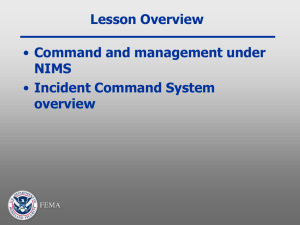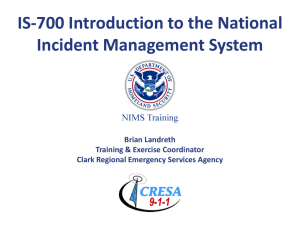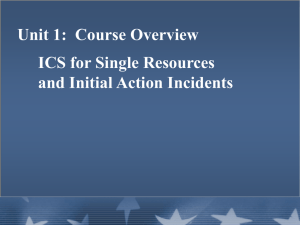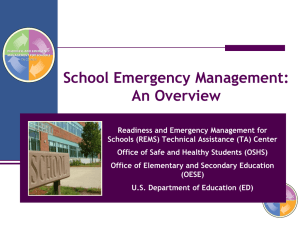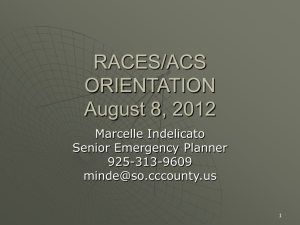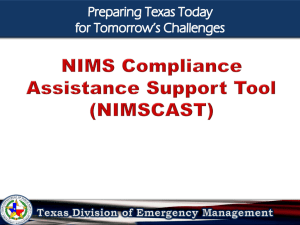Slides
advertisement
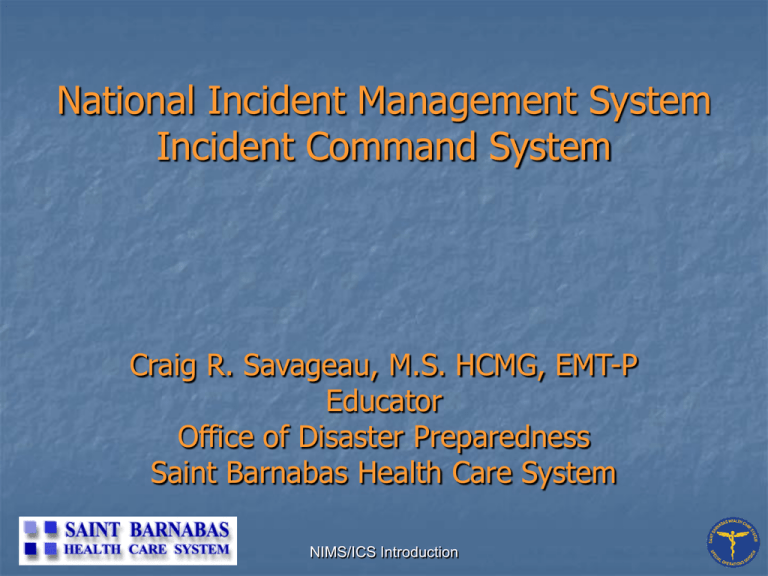
National Incident Management System Incident Command System Craig R. Savageau, M.S. HCMG, EMT-P Educator Office of Disaster Preparedness Saint Barnabas Health Care System NIMS/ICS Introduction WHY NIMS? Presidential Decision Directive -5 Executive Order 50 JCAHO Environment of Care Preparedness funding tied to compliance E.C. 1.4 e. Definition of a common (that is, "all-hazards") command structure within the organization for responding to and recovery from emergencies, that links with the command structure in the community. It works! NIMS/ICS Introduction What about HEICS? Hospital Emergency Incident Command System Not specifically NIMS compliance A version of ICS/IMS developed for hospitals HEICS and ICS have minor differences, defeating the intent of NIMS Concepts of HEICS can still be used while maintaining NIMS compliance Job Action Sheets NIMS/ICS Introduction History of ICS Developed in the 1970s as a result of devastating wildfires in California Needed a system to work toward common goals in efficient and effective manner Organizational charts and other techniques taken from business management principles NIMS/ICS Introduction The Incident Command System… IS a system to provide management during emergencies IS NOT an emergency operations plan DOES assist in developing an incident specific management structure DOES NOT replace existing hospital management structures NIMS/ICS Introduction Without an Incident Management System… CHAOS would result! NIMS/ICS Introduction Incident Command System Can be used for any size emergency – large or small Uses common terminology and operating procedures Timely combining of resources during an emergency System for controlling personnel, equipment, facilities, and communication NIMS/ICS Introduction UNDERSTANDING ICS KEY ELEMENTS Common Terminology Modular Organization Management by Objectives Incident Action Plans Manageable Span of Control Predestinated Incident Facilities Resource Management Integrated Communications Establishment and Transfer of Command Unity of command and Chain of Command Unified Command Accountability Deployment Information or Intelligence Management Flexibility NIMS/ICS Introduction Emergency Operations Center The center formerly know as the “Command Center” Emergency Operations Center is the correct NIMS terminology NIMS/ICS Introduction Emergency Operating Centers (EOC) The EOC is a predesignated facility established by an agency to coordinate the overall response and support to an emergency. NIMS/ICS Introduction EOC Mission NIMS/ICS Introduction Communication and Intelligence Strategic Direction Coordination and Documentation When do we activate the EOC? NIMS/ICS Introduction NIMS/ICS Introduction Predesignated Incident Facilities Established by the Incident Commander based on the requirements and complexity of the incident. Incident Command Post Staging Area NIMS/ICS Introduction Base Base Camp Command Post Dedicated central location Isolated from noise and other distractions Status board and other visual aids Let people know where it is and how to contact the CP NIMS/ICS Introduction Staging Area An area where resources are kept awaiting assignment May be predesignated May be multiple staging areas per incident NIMS/ICS Introduction Incident Facilities: Base Base: B Symbol Is the location from which primary logistics and administrative functions are coordinated and administered. There is only one Base per incident, and it is designated by the incident name. May be collocated with the Incident Command Post. Is established and managed by the Logistics Section. The resources in the Base are always out of service. NIMS/ICS Introduction Incident Facilities: Camps Camps: C Symbol Are where resources may be kept to support incident operations if a Base is not accessible to all resources. Multiple Camps may be used, but not all incidents will have Camps. Are temporary locations within the general incident area that are equipped and staffed to provide food, water, sleeping areas, and sanitary services. Are designated by geographic location or number. NIMS/ICS Introduction Tactical Resources Classifications Currently working on an assignment under the direction of a supervisor Ready for immediate assignment and has been issued all required equipment Not available or ready to be assigned (e.g., maintenance issues, rest periods) NIMS/ICS Introduction Other Incident Facilities HELISTOP HELIBASE NIMS/ICS Introduction UNDERSTANDING ICS Common terminology ICS uses standardized titles for positions, organizational levels, and facilities Allows for easier communication and organization between agencies NIMS/ICS Introduction UNDERSTANDING ICS Modular Organization Only the parts of the organization chart that are needed for the incident are activated Positions can stand up, and stand down as needed ICS is designed to expand or contract to fit the needs of the incident Levels can be added or deactivated depending on the size, scope, and/or nature of the incident NIMS/ICS Introduction UNDERSTANDING ICS Span of control Difficult and inefficient for one person to manage too many or too few people In order to maintain span of control, one person should only manage between 3-7 people/units (ideally 5) Less than 3 people/units – consider dissolving the supervisory position More than 7 people/units – an additional level of management should be added NIMS/ICS Introduction UNDERSTANDING ICS Unity of command Each unit or person within ICS should answer to ONE person Multiple superiors can lead to an inability to handle assigned tasks, or leave objectives unattained Staff accountability More effective flow of communication NIMS/ICS Introduction UNDERSTANDING ICS Unified Command concept Senior-level SMEs from different agencies/departments make joint decisions on strategic objectives Each “discipline” has a say in the decisionmaking process Communication and directives flow outward from unified command to various branches in the table of organization NIMS/ICS Introduction UNDERSTANDING ICS Unified Command Continued: Sharing of information, resources, and responsibility to ensure the smooth and efficient delivery of services One person (the incident commander) is “in charge” and sets the direction and focus of the group NIMS/ICS Introduction Reliance on an Incident Action Plan Every incident must have an Incident Action Plan (IAP) that: Specifies the incident objectives. States the activities to be completed. Covers a specified timeframe, called an operational period. May be oral or written—except for hazardous materials incidents, which require a written IAP. NIMS/ICS Introduction Elements of an Incident Action Plan Every IAP must have four elements: What do we want to do? Who is responsible for doing it? How do we communicate with each other? What is the procedure if someone is injured? NIMS/ICS Introduction Primary ICS Functions Incident Commander Command Information Staff Safety Liaison Operations Section Chief Planning Section Chief Logistics Section Chief General Staff NIMS/ICS Introduction Finance Section Chief POSITIONS WITHIN ICS Incident Commander (IC) Overall responsibility for the incident Every incident MUST have an Incident Commander First person on scene of an incident should establish a command May be replaced by a more qualified person as additional units arrive (Delegation of Authority) NIMS/ICS Introduction POSITIONS WITHIN ICS Responsibilities of the Incident Commander Establish scene safety Request additional resources (if necessary) Establish a staging area Establish an Incident Command Post Set incident objectives and priorities Appoint personnel to function in other ICS positions NIMS/ICS Introduction POSITIONS WITHIN ICS Operations Section Chief Work with the IC to ensure completion of goals Develop tactical objectives Manage units and resources to accomplish the objectives of the incident Oversees ICS elements tasked with operations dedicated to resolving and mitigating the incident NIMS/ICS Introduction Levels of Organization There can be additional levels of organization used under this (or any) section, known as: Branches Divisions Groups Task Force/Strike Team Single Resources NIMS/ICS Introduction Incident Commander Operations Section Chief Branch Branch Director Director Group Supervisor Task Force Strike Team Division Supervisor Task Force Strike Team NIMS/ICS Introduction POSITIONS WITHIN ICS Branches: Used to manage assets to help maintain span of control, and are an intermediate management level between the Operations Section and lower levels Can separate units by function, geography, or any other reason to maintain the span of control Common examples are EMS Branch, Fire Branch, and Law Enforcement Branch Are lead by Branch Directors There may be one deputy for each Branch Director NIMS/ICS Introduction POSITIONS WITHIN ICS Divisions: Established to divide an area geographically Named to describe the geographic area related to the incident operations Lead by a supervisor Not expected to need an assistant NIMS/ICS Introduction POSITIONS WITHIN ICS Groups: Established to manage a functional area of operations within a branch or a section Designed according to a specific task they are meant to carry out Lead by a supervisor Not expected to need an assistant NIMS/ICS Introduction POSITIONS WITHIN ICS Single Resource A lone resource, self lead NIMS/ICS Introduction POSITIONS WITHIN ICS Task Force: A collection of different resources tasked with a specific mission NIMS/ICS Introduction POSITIONS WITHIN ICS Strike Team: A collection of like resources that may be tasked with any mission NIMS/ICS Introduction POSITIONS WITHIN ICS Planning Section Responsible for developing short- and long-term plans Collects, evaluates, and displays information about the incident Maintains status of equipment and personnel Maintains incident documentation Led by Planning Section Chief NIMS/ICS Introduction POSITIONS WITHIN ICS Planning Section May be broken down into the following units: Resources Unit Situation Unit Documentation Unit Demobilization Unit Technical Specialists NIMS/ICS Introduction POSITIONS WITHIN ICS Planning Section Each unit is lead by a Unit Leader May have a unit manager assigned to the Leader Not all incidents will require the activation of a Planning Section, or all of the different units - in these cases the responsibilities of the section revert to the IC When there is a Planning Section, but not all of the units are established, those responsibilities fall back on the Planning Section Chief NIMS/ICS Introduction POSITIONS WITHIN ICS Logistics Section Responsible for all support and services needed at an incident - Personnel - Facilities - Equipment - Supplies NIMS/ICS Introduction POSITIONS WITHIN ICS Logistics Section This section will be established by the Incident Commander, depending on the needs of the incident May be broken down into two functional Branches: Service Branch Support Branch Each of these branches is overseen by a Branch Director Each branch can contain three functional units; not all of these units may be required at a specific incident NIMS/ICS Introduction POSITIONS WITHIN ICS Service Branch Communications Unit Medical Unit Food Unit Support Branch Supply Unit Facilities Unit Ground Support Unit Each unit is lead by a Unit Leader, who may be assisted by a Unit Manager If the Logistics Section is not established, the responsibilities of that section falls back on the Incident Commander If the Logistics Section is established, but the two branches are not, the responsibility of each branch falls back on the Logistics Section Chief NIMS/ICS Introduction POSITIONS WITHIN ICS Finance Section Chief Oversees the Finance/ Administration section Usually only utilized at large scale events Responsible for tracking and recording costs and personnel time NIMS/ICS Introduction POSITIONS WITHIN ICS Finance There can be four units established within this section: Time Unit Cost Unit Procurement Unit Compensation Unit These units are established based on the particular needs of the incident, as deemed by the Incident Commander NIMS/ICS Introduction Common Responsibilities Mobilization Only mobilize to an incident when requested or when dispatched by an appropriate authority. Make sure that you receive a complete deployment briefing. NIMS/ICS Introduction Deployment Briefing Descriptive location and response area Incident check-in location Specific assignment (e.g., position, team designation, etc.) Reporting time Communications instructions (e.g., incident frequencies) Special support requirements (e.g., facilities, equipment transportation and offloading, etc.) Travel arrangements (if needed) NIMS/ICS Introduction Check-In at the Incident: The check-in process helps to: Ensure personnel accountability. Track resources. Prepare personnel for assignments and reassignments. Locate personnel in case of an emergency. Establish personnel time records and payroll documentation. Plan for releasing personnel. Organize the demobilization process. NIMS/ICS Introduction Check-In at the Incident: Procedures Check in only once at an authorized location: At the Incident Command Post At the Base or Camp(s) At the Staging Areas At the helibase With the Division/Group Supervisor NIMS/ICS Introduction Initial Incident Briefing Make sure that you receive an initial incident briefing. Current situation assessment and objectives Specific job responsibilities Location of work area Procedural instructions for obtaining additional resources Safety hazards and required safety procedures/Personal Protective Equipment (PPE), as appropriate NIMS/ICS Introduction Keep Accurate Incident Records Print or type all entries. Enter dates in month/day/year format. Use military 24-hour time. Use local time. Enter date and time on all forms and records. Fill in all blanks. Use N/A as appropriate. Section Chiefs and above assign a recordkeeper (scribe). NIMS/ICS Introduction Be Accountable for Your Actions Maintain chain of command and unity of command. Take direction from a single supervisor. Communicate potential hazards and changing conditions using clear text and Plain English. Act professionally and avoid/report prohibited activities such as: Sexual harassment or discrimination. Use of illegal drugs or alcohol. NIMS/ICS Introduction When Demobilizing (1 of 2) Complete all work assignments and required forms/reports. Brief replacements, subordinates, and supervisor. Evaluate the performance of subordinates. Follow incident and agency check-out procedures. Provide followup contact information. NIMS/ICS Introduction When Demobilizing (2 of 2) Return any incident-issued equipment or other nonexpendable supplies. Complete post-incident reports, critiques, evaluations, and medical followup. Complete any administration issues. Upon arrival at home, notify the home unit (i.e., whoever is tracking you) of your arrival and ensure your readiness for your next assignment. NIMS/ICS Introduction The Big Picture Incident Commander Operations Chief Rescue Branch Planning Chief Medical Branch Resourses Unit Logistics Chief Service Branch Service Branch Extraction Area Triage Area Situation Unit Safety Officer Communication Unit Supply Area Decon Area Treatment Area Documentation Unit Medical Unit Facilities Unit Food Unit Ground support Unit Staging Area Demobilization Unit Transportation Area Technical Specialists NIMS/ICS Introduction Let’s Organize! A major sewage leak has occurred in a Med/Surg Unit. The unit is full of patients The following goals must be achieved: Evacuate the patients Stop the leak Clean up the mess NIMS/ICS Introduction Let’s Organize Organize the initial response You have the following personnel 8 4 1 1 1 4 3 RNs LPN/Nursing Assistants Nurse Manager Vice President of Operations Engineering Manager Maintenance Staff Housekeeping Staff NIMS/ICS Introduction Let’s Organize! Implement the following portions of ICS Incident Commander Operations Section Branches Groups or Divisions What other portions of ICS could be implemented? NIMS/ICS Introduction Bonus Problem A small fire has broken out in a patient room The patient self evacuated the room Staff was unable to attack the fire, but did shut the door. Minor smoke is on the floor affecting some of the patients NIMS/ICS Introduction Bonus Problem Who is in charge of this incident initially? next? long term? Set up an ICS structure to accomplish the following goals: Evacuate the floor Extinguish the fire Triage/ care for patients over come by smoke (outside of the ED) NIMS/ICS Introduction NIMS/ICS Introduction For More Information Ryan S. McCormick, BS, NREMT-P Operations Manager Office of Disaster Preparedness rmccormick@sbhcs.com 973 322-4366 NIMS/ ICS Training www.fema.gov/nims NIMS/ICS Introduction
